Related Research Articles

Aviemore railway station serves the town and tourist resort of Aviemore in the Highlands of Scotland. The station, which is owned by Network Rail (NR) and managed by ScotRail, is on the Highland Main Line, 83 miles 31 chains from Perth, between Kingussie and Carrbridge, and is also the southern terminus of the Strathspey preserved railway.

Oban railway station is a railway station serving Oban in Scotland. It is the terminus of one branch of the highly scenic West Highland Line 101.3 miles (163 km) north of Glasgow Queen Street. It was originally the terminus of the Callander and Oban Railway. Services are operated by ScotRail.

Inverness railway station is the railway station serving the Scottish city of Inverness. It is the terminus of the Highland Main Line, the Aberdeen–Inverness line, the Kyle of Lochalsh line and the Far North Line.

Nairn railway station is a railway station serving the town of Nairn in Scotland. The station is managed by ScotRail and is on the Aberdeen to Inverness Line. It is a category B listed building. The station appeared as 'Inverness' in the 1970 film The Private Life of Sherlock Holmes.

Forres railway station serves the town of Forres, Moray in Scotland. The station is managed by ScotRail and is on the Aberdeen–Inverness line.

Elgin railway station is a railway station serving the town of Elgin, Moray in Scotland. The station is managed by ScotRail and is on the Aberdeen to Inverness Line.
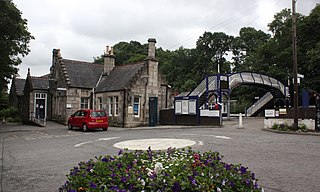
Pitlochry railway station, located on the Highland main line, serves the town of Pitlochry in Perth and Kinross, Scotland. It is served regularly by ScotRail trains between Glasgow or Edinburgh and Inverness, the daily Caledonian Sleeper service to and from London Euston and the daily London North Eastern Railway service between London King's Cross and Inverness via York along the East Coast Main Line.
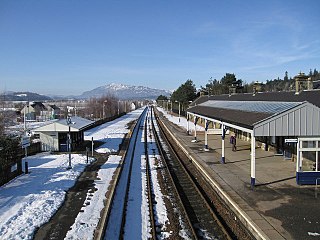
Kingussie railway station serves the town of Kingussie, Inverness-shire in the Highland Council Area of Scotland. The station is managed by ScotRail and is on the Highland Main Line, 71 miles 43 chains (115.1 km) from Perth, between Newtonmore and Aviemore.

Newtonmore railway station serves the village of Newtonmore, Highland, Scotland. The station is managed by ScotRail and is on the Highland Main Line. The station is 68 miles 62 chains (110.7 km) from Perth, between Dalwhinnie and Kingussie, and has a single platform which is long enough for a ten-coach train. It is currently the only station on the Highland Main Line to have one platform, although the former second platform can still be seen adjacent to the first platform.

Dalwhinnie railway station is a railway station serving the village of Dalwhinnie, Highland, Scotland. The station is managed by ScotRail and is on the Highland Main Line, 58 miles 47 chains (94.3 km) from Perth, between Blair Atholl and Newtonmore, at an elevation of 1,174 feet (358 m).
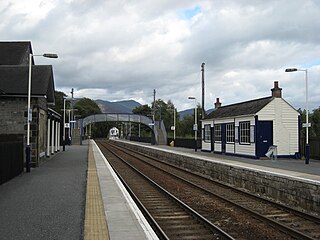
Blair Atholl railway station is a railway station serving the town of Blair Atholl, Perth and Kinross, Scotland. The station is managed by ScotRail and is on the Highland Main Line, 35 miles 9 chains (56.5 km) from Perth, between Pitlochry and Dalwhinnie.
The Scottish Central Railway was formed in 1845 to link Perth and Stirling to Central Scotland, by building a railway line to join the Edinburgh and Glasgow Railway near Castlecary.

The Invergarry and Fort Augustus Railway was a branch-line railway built in Scotland, connecting the named places with the main line at Spean Bridge. It opened in 1903.
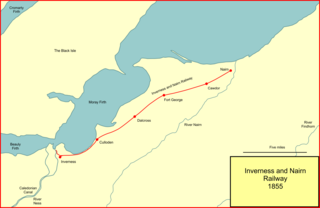
The Inverness and Nairn Railway was a railway company that operated between the burghs in the company name. It opened its line in 1855 and its passenger business was instantly successful. At first it was not connected to any other line. However it was seen as a first step towards connecting Inverness and Central Scotland, via Aberdeen and when feasible, directly southwards.
The Inverness and Aviemore Direct Railway was a section of railway built by the Highland Railway to provide a shorter and more direct route between Inverness and Aviemore, carrying its main line traffic to Perth and the south.
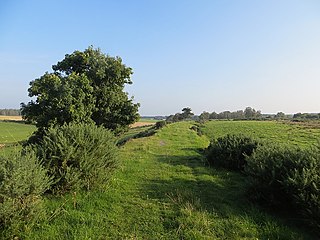
The Inverness and Perth Junction Railway (I&PJR) was a railway company that built a line providing a more direct route between Inverness and the south for passengers and goods. Up to the time of its opening, the only route was a circuitous way through Aberdeen. The I&PJR was built from a junction with the friendly Inverness and Aberdeen Junction Railway at Forres to the Perth and Dunkeld Railway at Dunkeld.
The Inverness and Aberdeen Junction Railway (I&AJR) was a railway company in Scotland, created to connect other railways and complete the route between Inverness and Aberdeen. The Inverness and Nairn Railway had opened to the public on 7 November 1855 and the Great North of Scotland Railway (GNoSR) was building from Aberdeen to Keith. The I&AJR opened, closing the gap, on 18 August 1856.
The Strathspey Railway was a railway company in Scotland that ran from Dufftown (in Moray to Boat of Garten (in Badenoch and Strathspey]], Scotland. It was proposed locally but supported by the larger Great North of Scotland Railway, which wanted to use it as an outlet towards Perth. The GNoSR had to provide much of the funding, and the value of traffic proved to be illusory. The line opened in 1863 to Abernethy, but for the time being was unable to make the desired connection to the southward main line. Although later some through goods traffic developed, the route never achieved its intended purpose.
The Newburgh and North Fife Railway was a Scottish railway company formed to build a connecting line between St Fort and Newburgh, in Fife, intended to open up residential traffic between the intermediate communities and Dundee and Perth. It opened its line, which was expensive to construct, in 1909 but the local traffic never developed. It closed to passenger traffic in 1951, and completely in 1964.
The Killiecrankie railway station served the village of Killiecrankie, Perth and Kinross, Scotland from 1864 to 1965.
References
- ↑ "Serious Accident on the Highland Railway" . Dundee Courier. Scotland. 7 September 1877. Retrieved 19 August 2020– via British Newspaper Archive.
- ↑ "Struan Railway Station Burned" . Dundee Courier. Scotland. 22 October 1897. Retrieved 19 August 2020– via British Newspaper Archive.
- ↑ Byrom, Bernard (2022). Old Blair Atholl, Killiecrankie and Struan. Catrine: Stenlake Publishing Ltd. p. 45. ISBN 978-1-84033-929-1.
- ↑ "Struan Station". Canmore. Retrieved 2 October 2017.